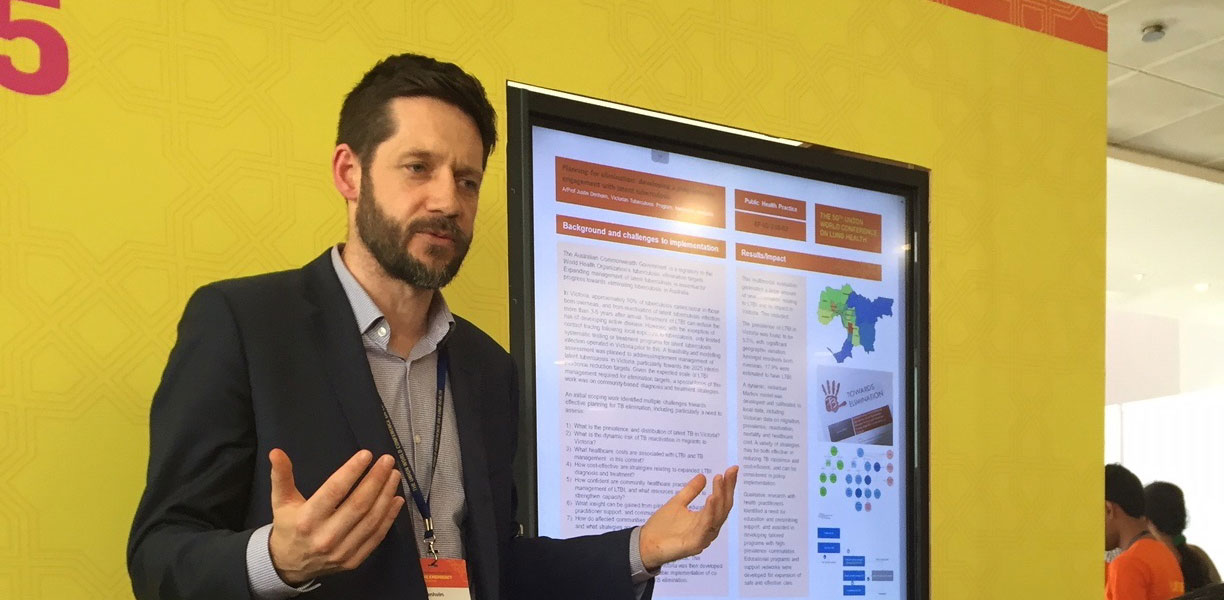12 Nov 2019
The International Union World Conference on Lung Health
Epidemiologist Katie Dale attended the International Union World Conference on Lung Health earlier this month. Here she shares her insights.
Several of us from the Doherty Institute were fortunate enough to attend the 50th International Union in Hyderabad, India, title “Ending the emergency: Science, leadership, action”.
India can be overwhelming, diverse, chaotic, exasperating, intoxicating and intriguing; a place of contrasts and inescapable humanity and, in many ways, the conference could be described similarly.
The main conference was preceded by the 8th Union President’s Centennial Dinner held at the opulent Taj Falaknuma Palace, where diners were serenaded with traditional music and rose petals fell from the sky.
In contrast, the friday plenary session on air pollution titled “Deadly Air” coincided with the declaration of a public health emergency in Delhi, where air quality was hundreds of times higher than safe limits.
The three-day conference was packed with an overwhelming schedule of plenaries, seminars, symposiums, posters, e-posters and meetings and was preceded by two full days of “TB Science” (an official event entirely devoted to basic and translational TB research) and one day of post-graduate courses and workshops. It was impossible to attend everything of interest, and is equally impossible to summarise all of the highlights, but a limited selection are listed below.

Associate Professor Justin Denholm presents a poster at the conference
Importantly too, the conference was greatly enriched with many voices of TB survivors, who discussed the challenges and stigma they faced during their illness and treatment, and the ongoing challenges they still face every day. This was especially valuable to researchers like me who may seldom hear these stories and hear of the human cost of TB. Equally humbling was having the opportunity to spend time with so many delegates from such diverse corners of the globe, and to hear of the enormous challenges that many face with so few resources.
The conference undoubtedly left me with many mixed feelings. The global burden of TB is utterly overwhelming, and yet it was heartening to learn that so many capable people are tackling the challenge on so many fronts. Ultimately, like India, there is nothing to do but to embrace it all and be immensely grateful for such an enriching experience.
A limited selection of highlights from the conference:
- The results of a trial for a new TB vaccine known as M72/AS01E showed it to prevent 49.7% of pulmonary TB development at 36 months in 18-50 year olds who were interferon-gamma-release-assay (IGRA) positive and HIV-negative. Pulmonary TB developed in 13/1,626 in the vaccinated group, as compared to 26/1,663 in the placebo group (manuscript)
- An agreement between Sanofi, Unitaid and the Global Fund was announced to lower the price of rifapentine by 66 percent within the public sectors of low- and middle-income countries with a high burden of TB and TB-HIV. Rifapentine is a drug that can be used in combination with Isoniazid to prevent latent TB reactivation.
- The results of a study that placed masks on suspected TB patients demonstrated that the aerosol patterns of Mycobacterium tuberculosis were heterogeneous and not correlated to either sputum smear positivity or cough (Caroline Williams)
- There were many reports on the ability of certain biomarkers (including gene signatures, immune cells, and metabolites) to predict TB progression several months prior to diagnosis (Claudia Denkinger).
- A phase 1 trial of Delpazolid showed it to have less toxicity than Linezolid, a drug that is currently used for the treatment of multi-drug resistant TB (MDR-TB) and extensively drug resistant TB (XDR-TB) (Lawrence Geiter).
- There are many current trials investigating the efficacy of shorter treatment regimens for latent TB. One month of isoniazid and rifapentine was recently shown to be non-inferior to nine months of isoniazid in HIV-positive patients who were predominantly tuberculin-skin-test negative, and mouse data suggests that a two week regimen or even a long-acting injectable bedaquiline may be possible in the future (Gavin Churchyard);
- Several presentations highlighted the likely importance of identifying cases of sub-clinical TB (i.e. culture positive disease prior to symptom onset) and there was reportedly much more of a focus on active-case-finding in this conference as compared to previous years.
- There were many presentations on “scaling up” of latent TB treatment in close contacts and other at-risk populations, including those with HIV, and the associated challenges.
- A population-wide TB screening and mass latent TB treatment project in Majuro in the Marshall Islands reported that in the TST positive group the five year TB-rate from 2012-2016 was 922, as compared to the annualised rate in 2019 of 517 in those with active case finding and 151-185 int those with active case finding and LTBI treatment.
…and, of course, there was plenty of healthy debate about the significance, or not, of these various developments.


